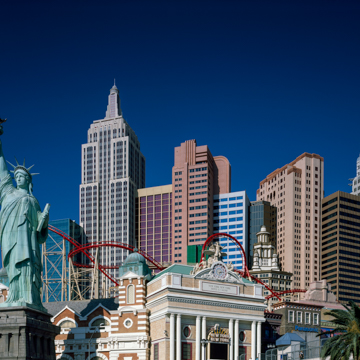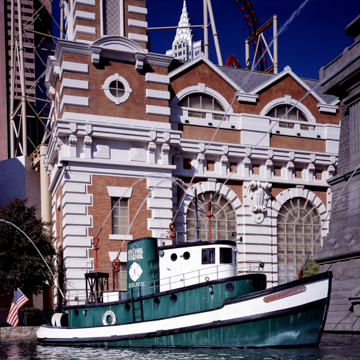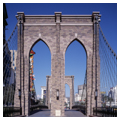Continuing the trend of building ducks rather than decorated sheds, one of Las Vegas's newest casinos presents a compressed skyline of Manhattan. Modified versions of such famous landmarks as the Statue of Liberty, Ellis Island, the Empire State Building, and Lever House, at about one-third their actual size, rise from the base of a single building housing the casino. These towers contain hotel rooms and elevator shafts. Walking south on the Strip, visitors cross a scale model of the Brooklyn Bridge to enter the casino. Though these structures evoke their models, the garish colors, lights, and roller coaster racing around the exterior of the complex leave no doubt that this is Las Vegas. The dark interior, typical of many casinos, allows illuminated gambling machines to dominate the experience by shining brightly in the gloom. Yates-Silverman, a Las Vegas design firm responsible for many of the Strip's newest interiors, created echoes of Times Square and Little Italy as themes for various areas of the gambling floor; a large room called SoHo houses shops. The cage, where much of the casino's cash is stored, is hidden beyond a copy of the New York Stock Exchange facade. Though New York is the theme, the casino's owners intended to re-create not contemporary Manhattan but rather the New York of a generation ago—a mythical and glamorous city. Only the crowds inside give New York New York the population density of the metropolis.
You are here
New York New York
If SAH Archipedia has been useful to you, please consider supporting it.
SAH Archipedia tells the story of the United States through its buildings, landscapes, and cities. This freely available resource empowers the public with authoritative knowledge that deepens their understanding and appreciation of the built environment. But the Society of Architectural Historians, which created SAH Archipedia with University of Virginia Press, needs your support to maintain the high-caliber research, writing, photography, cartography, editing, design, and programming that make SAH Archipedia a trusted online resource available to all who value the history of place, heritage tourism, and learning.



















